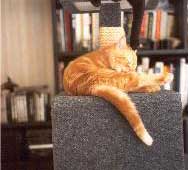| 
Crazy Cats - 'The Mad Half
Hour'
Dr David Sands PhD - animal behaviourist of Animal Behavioural
Clinic, Chorley discusses why cats have flashes of madness.
Most cat keepers cannot help but notice the 'mad half hour'
when it first occurs. A cat will suddenly seemingly fly down
stairs without touching treads. If there's another cat in the
home, another frenzied feline will be following in hot pursuit.
Vases can fall. Phantom shadows can be chased. Settees can be
vaulted, curtains can be climbed. Hanging threads and table
cloths can be teased to the floor. Collisions will undoubtedly
occur. Sometimes humans get in the way. Too bad. There can be
rough and tumble. There can also be vocalisation of this feline
madness. Wahhhrrrrsssss and meows. Sometimes flight can come
to a dead stop. Claws out, retro on. The 'mad half hour' can
have several stops and starts. The common pattern is the daily
half hour.
So, what's it all about? Well, the 'mad half hour syndrome'
appears to affect most cats. House cats are thought to experience
them the most. They are about expending energy in one concentrated
burst. Cats that are content to stay indoors are not expending
the same energy as outdoor cats. Wandering outside the home
for a cat probably takes up a great deal of energy especially
when wall and tree climbing skills are brought into play. Cat
personalties can also play a big part.
When your cat suddenly dashes behind the sofa and looks at you
with that little "look at me!" face?
This part of cat behaviour is all about 'stalking and hunting'.
All play behaviour is a prelude for the real thing'. The cat
is looking' for interaction from another cat' (that can be the
keeper in the cat's perception) and instinct takes over during
an adrenalin?driven game. You, as the keeper, simply become
part of it.
There are many forms of play behaviour that can be seen to be
an adaptation. Cats crash through newspaper or paper bags so
enthusiastically because bursting through materials is no different
to bursting through undergrowth or leaves.
Cats wiggle their back legs as they get ready to pounce on a
bit of fluff on
the carpet because this prepares them for a 'leap' ? a kind
of balance check' before 'the pounce'. These play behaviours
in domestication are modes of behaviour linked to prey stalking,
attacking and predation in nature.
The shape of behaviour
There are two major forces that help shape the character of
domesticated cats. The first force is genetic and, despite the
many generations between the pet cat and the wild African or
Eurasian animals, the same instincts have been carried faithfully
gene by gene along the DNA trail. This dictates all physiological
and most behavioural developments including skeletal development,
reproduction, parental care, feeding, agility, coat, eyes etc
The second force is behavioural and this aspect is continually
effected by domestication and, in the life of a kitten to cat,
what is learned from the litter mother from birth and the environmental
circumstances surrounding the initial development. There could
be arguments about the exact percentages of influence between
genetic and learned forces in behaviour (the old Nature over
Nurture debate) but it might be estimated around 75% instinctive
and 25% learned.
Following what a cat has inherited directly from its parent's
genes, it is the learned behaviour and environmental conditions
that will shape its developing character. A kitten born to feral
parents beneath the ruins of a old barn will certainly have
all its instincts sharpened at a fast rate. It will quickly
learn prey types, how to hunt for food and how to avoid potential
predators. Such a kitten would be aware and could appear to
be 'crazy' or 'permanently anxious or nervous' (hyper-alert)
once it had been brought into a home. In contrast, a kitten
born in the comfort of the washroom tucked into a warm blanket
with a litter mother that is fat and content is hardly likely
to care from which side of the jug its cream is poured. Life
for a kitten is only about milk and sleep and play.
The classification of a cat's personality depends entirely on
the DNA passed on by its mother and father and the environmental
circumstances of its birth. How seriously the litter mother
takes parenting is then the next critical step and another story.
The 'Woody Allen' Cat
The mad half hour cat is usually a neurotic. It doesn't simply
have to live on the streets of New York to need a therapist.
Maybe some feral cat influence has created hyper-alertness and
an extrovert personality. Many's a sneaky mating been made by
a feral cat taking on a pet tabby 'new to the tiles'. On the
other hand, a cat's influence towards daftness can have its
roots in a lively litter - fraternity members of which would
always be on the mischief hunt. Nonetheless, introverted neurotic
cats can be just as prone to the 'mad half hour syndrome'. A
nervous cat may hide for most of its time underneath the sideboard,
under the kitchen units or in the back bedroom but it too, can
suddenly burst into life and chase ghosts and shadows.
In nature, a wild or feral cat may spend as much as 50% of
its time looking for food. In domestication this is usually
modified because most keepers kindly do the bulk of 'hunting
and foraging' for their pets. The 'kill' may start out as lines
of cans or in bags on a supermarket shelf and will end up in
a carrier bag that has 'Sainsbury, Asda or Tesco' printed on
it but that is what your shopping represents to a pet. You've
been hunting and foraging and what have you brought back -'
Whiskas' or 'Sheba'!
In kittens, play and interaction with litter siblings, is closely
related to learning hunting techniques. Development of some
play behaviours in young cats is about sharpening predator skills.
There has to be some adaptation between nature and a tamed
life. Perhaps in domestication, the house cat - without the
life-necessity to 'hunt, stalk and forage' - has to somehow
make up for such a major loss of lifestyle. A play cat's pupils
dilate (due to the sympathetic nervous system) when they're
in "mad" phase because the 'fight or flight' syndrome.
This adrenalin-driven reaction which also increases heart rate
and blood flow and generally heightens the senses of an animal
relates to a need in nature to be watchful ie improving vision,
speed and mobility.
Unless we can see the world from a cat's perspective and get
inside its mind - we can only guess what's truly going on during
the wonderful 'mad half hour'. My two pedigree cats have made
me laugh a time or two during madness spells. Especially when
they collide. Perhaps my reaction to a cat's 'mad half hour
condition' is related to the 'Laurel and Hardy syndrome'. Their
antics made me laugh and run around the house when I was a just
a 'kitten'.
|







